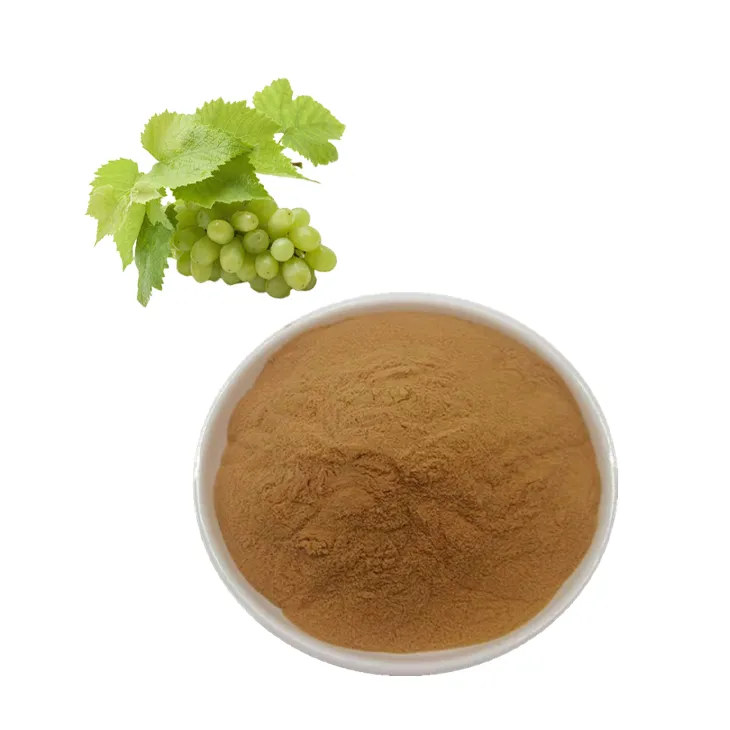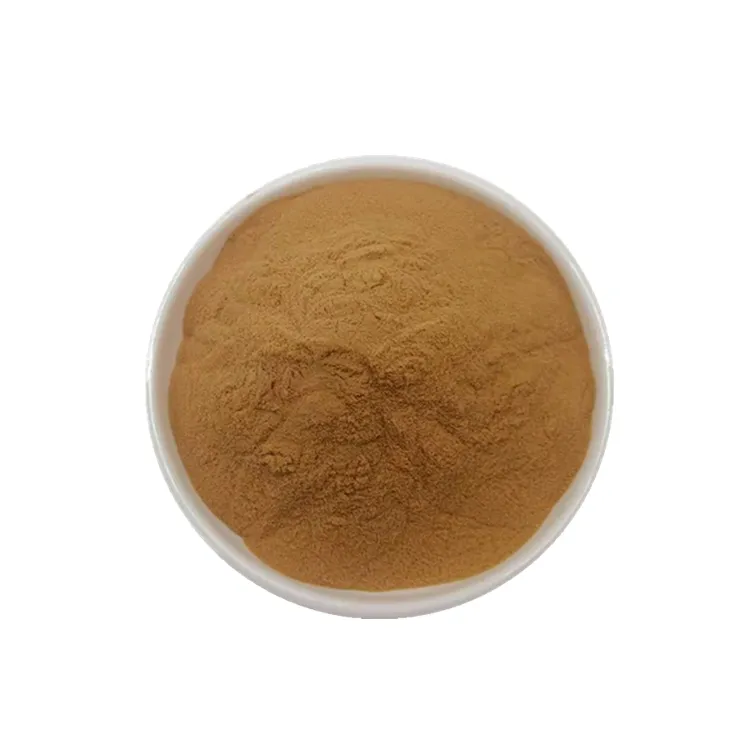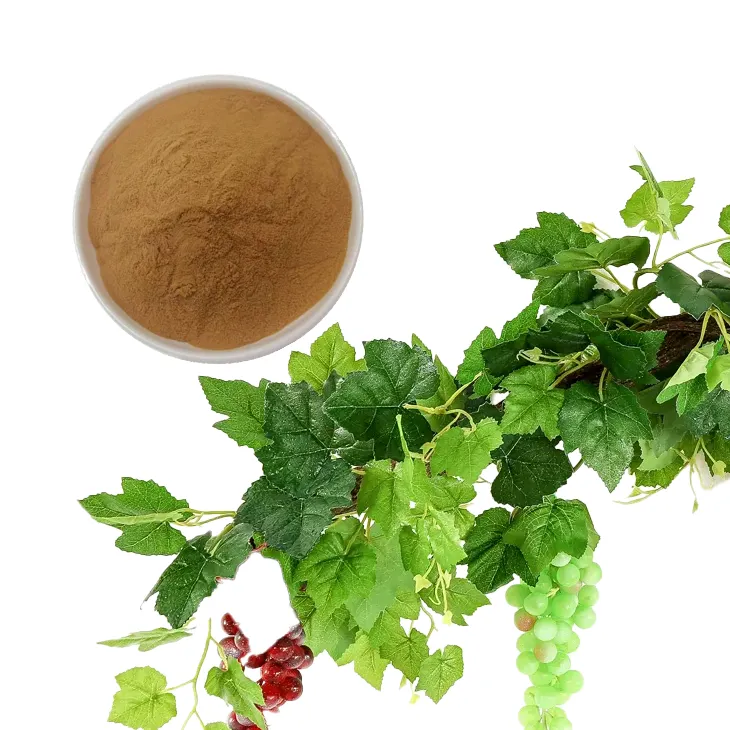- 0086-571-85302990
- sales@greenskybio.com
How to make powder from grape leaf extract?
2024-11-30

1. Introduction
Grape Leaf Extract has gained significant attention in recent years due to its potential health benefits and various applications in different industries. The process of converting Grape Leaf Extract into powder form involves several crucial steps, including extraction techniques, purification, and the final transformation into a powder. This article will explore these steps in - depth and also discuss the uses of Grape Leaf Extract powder in different sectors as well as its significance in health and wellness.

2. Extraction techniques
2.1 Solvent extraction
Solvent extraction is one of the most common methods used to obtain grape leaf extract. In this process, a suitable solvent is selected based on the chemical properties of the desired compounds in the grape leaves. Commonly used solvents include ethanol, methanol, and water.
- First, the grape leaves are thoroughly washed to remove any dirt, pesticides, or other contaminants. This is a crucial step as it ensures the purity of the final extract.
- After washing, the leaves are dried. Drying can be done using natural methods such as air - drying or through the use of drying equipment like ovens at a low temperature to preserve the bioactive compounds.
- Once dried, the leaves are ground into a fine powder. This increases the surface area, facilitating better extraction.
- The powdered leaves are then mixed with the selected solvent in a suitable ratio. For example, if using ethanol, a ratio of 1:10 (leaf powder to solvent) may be used, depending on the extraction requirements.
- The mixture is then placed in a shaker or stirred continuously for a specific period, usually several hours to days. This allows the solvent to dissolve the desired compounds from the leaf powder.
- Finally, the mixture is filtered to separate the liquid extract from the solid residue. The resulting liquid contains the grape leaf extract.
2.2 Supercritical fluid extraction
Supercritical fluid extraction is a more advanced and efficient method. Supercritical carbon dioxide (scCO₂) is often used as the extraction fluid. It has several advantages over traditional solvent extraction methods.
- The grape leaves are first prepared in a similar way as in solvent extraction, i.e., washing, drying, and grinding.
- The scCO₂ is pressurized and heated above its critical point, which gives it unique properties that enable it to act as both a liquid and a gas simultaneously. This allows it to penetrate the cells of the grape leaves more effectively.
- The scCO₂ is passed through the powdered grape leaves in an extraction vessel. The pressure and temperature are carefully controlled during this process.
- As the scCO₂ extracts the desired compounds from the leaves, it is then passed through a separator where the pressure is reduced. This causes the scCO₂ to return to its gaseous state, leaving behind the concentrated grape leaf extract.

3. Purification steps
3.1 Filtration
After extraction, the grape leaf extract may contain impurities such as fine particles of the leaf, undissolved substances, or even traces of the extraction solvent. Filtration is the first step in purification.
- Simple filtration using filter paper can be carried out to remove larger particles. This can be done in a Buchner funnel under vacuum for faster filtration.
- For more refined filtration, membrane filters with different pore sizes can be used. For example, a 0.45 - micrometer membrane filter can be used to remove smaller particles and bacteria, while a 0.22 - micrometer filter can be used for even more stringent purification.
3.2 Centrifugation
Centrifugation is another important purification step. It is useful for separating substances with different densities.
- The grape leaf extract is placed in centrifuge tubes and spun at a high speed in a centrifuge. The speed and time of centrifugation depend on the nature of the impurities and the desired purity of the extract.
- During centrifugation, denser particles will sediment at the bottom of the tube, while the purified extract will remain in the supernatant. The supernatant can then be carefully decanted or aspirated for further processing.
3.3 Chromatographic purification
Chromatographic purification is a more sophisticated method used for separating and purifying specific compounds in the grape leaf extract.
- There are different types of chromatography that can be used, such as high - performance liquid chromatography (HPLC) or column chromatography. In HPLC, the extract is pumped through a column filled with a stationary phase at a high pressure.
- Different compounds in the extract will interact differently with the stationary phase and the mobile phase (the solvent used to carry the extract through the column). This results in their separation based on their chemical properties.
- Column chromatography is a more traditional method where the extract is loaded onto a column filled with a solid adsorbent, such as silica gel or alumina. The compounds are then eluted from the column using different solvents with increasing polarity, separating the components based on their affinity for the adsorbent and the solvents.

4. Conversion to powder form
4.1 Evaporation
Once the grape leaf extract has been purified, the next step is to convert it into powder form. Evaporation is a common method used to remove the solvent and concentrate the extract.
- The purified extract is placed in a shallow dish or a rotary evaporator. If using a rotary evaporator, the temperature and pressure are carefully controlled to ensure efficient evaporation without damaging the bioactive compounds.
- As the solvent evaporates, the extract becomes more concentrated. This process is continued until a thick, viscous liquid or a semi - solid paste is obtained.
4.2 Spray drying
Spray drying is a popular method for converting liquid extracts into powder form.
- The concentrated grape leaf extract is first made into a fine spray using a spray nozzle. This is usually achieved by pumping the extract through a high - pressure pump.
- The fine spray is then introduced into a drying chamber where hot air is circulated. The hot air quickly evaporates the remaining solvent from the droplets of the extract, leaving behind dry powder particles.
- The powder particles are then collected at the bottom of the drying chamber or in a cyclone separator.
4.3 Freeze drying
Freeze drying, also known as lyophilization, is another method for obtaining powder from the grape leaf extract.
- The purified extract is first frozen at a very low temperature, usually below - 40°C. This freezes the water and other solvents present in the extract.
- The frozen extract is then placed in a freeze - dryer, where the pressure is reduced. Under reduced pressure, the frozen solvent sublimes, i.e., it changes directly from a solid to a gas without passing through the liquid state.
- As the solvent is removed in this way, the remaining solid material forms a porous powder. This powder has a high stability and can retain the bioactive properties of the grape leaf extract.
5. Uses in different industries
5.1 Pharmaceutical industry
Grape leaf extract powder has potential applications in the pharmaceutical industry. Antioxidant properties of the extract can be harnessed for developing drugs or supplements to combat oxidative stress - related diseases.
- It may be used in the formulation of anti - inflammatory drugs due to its anti - inflammatory compounds. These can help in reducing inflammation in conditions such as arthritis.
- The extract powder can also be investigated for its potential in treating cardiovascular diseases. Some of the compounds in grape leaf extract may help in reducing blood pressure, improving blood lipid profiles, and preventing platelet aggregation.
5.2 Cosmetic industry
In the cosmetic industry, grape leaf extract powder is used for its various beneficial properties.
- Its antioxidant properties make it a valuable ingredient in anti - aging creams and serums. It can help in reducing the appearance of wrinkles and fine lines by neutralizing free radicals that damage the skin cells.
- The extract powder can also be used in skin - whitening products. Some of the compounds in grape leaf extract may inhibit the production of melanin, the pigment responsible for skin color, leading to a lighter complexion.
- It has moisturizing properties as well. When added to lotions or creams, it can help in keeping the skin hydrated.
5.3 Food industry
The food industry also makes use of grape leaf extract powder.
- It can be used as a natural food additive to enhance the nutritional value of food products. For example, it can be added to breakfast cereals, energy bars, or juices.
- As a preservative, the antioxidant properties of the extract powder can help in extending the shelf - life of food products by preventing lipid oxidation and microbial growth.
- It can also be used in the production of functional foods. Functional foods are those that provide additional health benefits beyond basic nutrition. Grape leaf extract powder - fortified foods can target specific health concerns such as improving digestion or boosting the immune system.
6. Significance in health and wellness
Grape leaf extract powder has significant importance in promoting health and wellness.
- As mentioned earlier, its antioxidant properties play a crucial role in protecting the body from oxidative damage. Oxidative damage is associated with various chronic diseases such as cancer, diabetes, and neurodegenerative diseases.
- The anti - inflammatory compounds in the extract powder can help in reducing chronic inflammation in the body. Chronic inflammation is a key factor in many diseases, including autoimmune disorders.
- Some of the bioactive compounds in grape leaf extract powder may also have a positive impact on gut health. They can promote the growth of beneficial gut bacteria and improve digestion.
- It may also contribute to cardiovascular health by reducing risk factors such as high blood pressure and abnormal blood lipid levels.
7. Conclusion
The process of making powder from grape leaf extract involves a series of well - defined steps, from extraction techniques to purification and finally conversion to powder form. The resulting powder has diverse applications in different industries and significant importance in health and wellness. As research on grape leaf extract continues, more potential uses and benefits are likely to be discovered, further enhancing its value in various fields.
FAQ:
Q1: What are the initial steps for extracting substances from grape leaves?
First, fresh and clean grape leaves need to be selected. Then, a suitable solvent such as ethanol or water can be used for extraction. Maceration or Soxhlet extraction methods are often employed. Maceration involves soaking the grape leaves in the solvent for a period, usually several hours to days, while Soxhlet extraction is a continuous extraction process that can be more efficient for obtaining a larger amount of extract.
Q2: How can the extracted grape leaf substances be purified?
Purification can be achieved through various methods. Filtration is a common initial step to remove solid impurities. Then, techniques like chromatography can be used. For example, column chromatography can separate different components based on their different affinities to the stationary and mobile phases. Another method could be centrifugation to further separate any remaining particulate matter or unwanted substances.
Q3: What is the process of converting the purified grape leaf extract into powder?
One common method is freeze - drying. The purified extract is frozen and then placed in a vacuum chamber where the ice sublimes directly from the solid to the gas phase, leaving behind a dry powder. Another option is spray - drying, where the extract is sprayed into a hot chamber. The water in the extract evaporates quickly, resulting in powder formation.
Q4: In which industries can grape leaf extract powder be used?
In the food industry, it can be used as a natural additive, for example, in dietary supplements or functional foods due to its potential health - promoting properties. In the pharmaceutical industry, it may be studied for its medicinal properties and could be used in the development of drugs. In the cosmetic industry, it can be added to skincare products as it may have antioxidant properties that can help protect the skin.
Q5: What are the health benefits associated with grape leaf extract powder?
Grape leaf extract powder may have antioxidant properties, which can help neutralize free radicals in the body. It may also have anti - inflammatory effects, potentially helping with various inflammatory conditions. Additionally, some studies suggest it could have a positive impact on cardiovascular health, for example, by helping to regulate blood pressure.
Related literature
- Extraction and Characterization of Bioactive Compounds from Grape Leaves"
- "The Potential Health Benefits of Grape Leaf Extract: A Review"
- "Industrial Applications of Grape Leaf - Derived Products"
- ▶ Hesperidin
- ▶ citrus bioflavonoids
- ▶ plant extract
- ▶ lycopene
- ▶ Diosmin
- ▶ Grape seed extract
- ▶ Sea buckthorn Juice Powder
- ▶ Beetroot powder
- ▶ Hops Extract
- ▶ Artichoke Extract
- ▶ Reishi mushroom extract
- ▶ Astaxanthin
- ▶ Green Tea Extract
- ▶ Curcumin Extract
- ▶ Horse Chestnut Extract
- ▶ Other Problems
- ▶ Boswellia Serrata Extract
- ▶ Resveratrol Extract
- ▶ Marigold Extract
- ▶ Grape Leaf Extract
- ▶ blog3
- ▶ blog4
-
Bulk purchase of silymarin extract.
2024-11-30
-
Certified organic baicalin.
2024-11-30
-
The best organic L - tyrosine.
2024-11-30
-
100% Pure Organic Mulberry Extract.
2024-11-30
-
Organic Melatonin Powder Factory.
2024-11-30
-
Shikonin Suppliers.
2024-11-30
-
Kupilu Extract
2024-11-30
-
Green coffee bean Extract
2024-11-30
-
Apricot Powder
2024-11-30
-
Selenium yeast
2024-11-30
-
Fenugreek Extract Powder
2024-11-30
-
Mangosteen extract powder
2024-11-30
-
Hedyotis Diffusa Extract
2024-11-30
-
Grape Seed Extract
2024-11-30
-
Curcumin
2024-11-30
-
Hericium erinaceus extract powder
2024-11-30





















